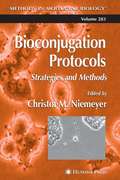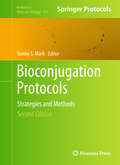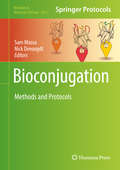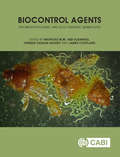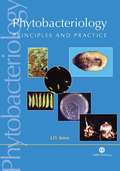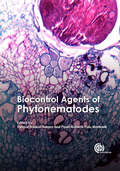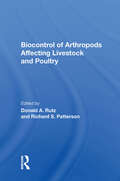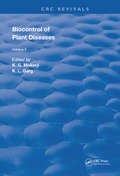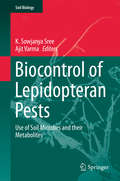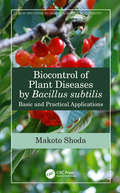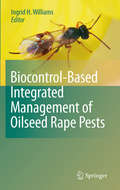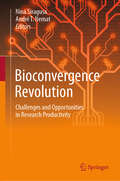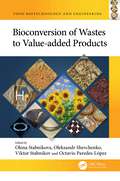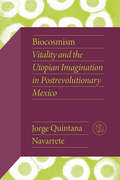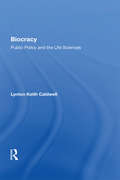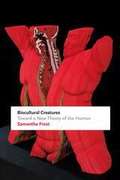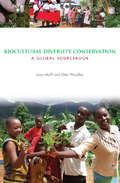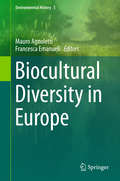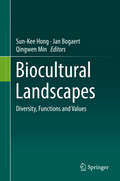- Table View
- List View
Biocon: Launching a New Cancer Drug in India
by Sunil Gupta Das NarayandasKiran Majumdar-Shaw, the CEO of Biocon has to make product launch timing, pricing, channel, and communications mix decisions relating to the launch of BioMAb, a new cancer drug in India.
Bioconjugation Protocols: Strategies and Methods (Methods in Molecular Biology #283)
by Christof M. NiemeyerExpert laboratorians update the classic bioconjugation methods and introduce valuable new techniques that go beyond pure biomedical applications to include elements from advanced organic synthesis, molecular biology, and materials science. These readily reproducible methods cover the preparation of protein conjugates using covalent and noncovalent conjugation, the synthesis of nucleic acid conjugates using a variety of labeling techniques, and approaches to semisynthetic conjugates of proteins. Additional chapters address the biofunctionalization of inorganic surfaces, including the on-chip synthesis of peptide nucleic acids to generate microarrays for the high-throughput analysis of RNA and DNA, gold nanaoparticles, and carbon nanotube probes for atomic force microscopy.
Bioconjugation Protocols: Strategies and Methods (Methods in Molecular Biology #751)
by Sonny S. MarkContemporary approaches to the synthesis of chemically modified biomacromolecules (proteins, nucleic acids, lipids, and carbohydrates) not only require efficient means to control conjugation and the specific site of attachment of the conjugated moiety but also the effective use of recent developments in the fields of pharmaceutical chemistry, biomolecular/polymer engineering, and nanobiotechnology. In this second edition of Bioconjugation Protocols: Strategies and Methods, expert researchers update the classic methods and introduce valuable new approaches that go beyond basic conjugation techniques to include elements from advanced organic synthesis, molecular biology, surface biotechnology, materials science, and nanobioscience/engineering. These readily reproducible methods cover the preparation of biomolecular conjugates using a variety of labeling techniques and semisynthetic approaches. Additional chapters address the biofunctionalization of surface structures, including organic/inorganic thin films, as well as various types of nanostructures (magnetic nanoparticles, quantum dots, carbon nanotubes, and silicon nanowire devices). All the protocols follow the successful Methods in Molecular BiologyTM series format, each one offering step-by-step laboratory instructions, an introduction outlining the principle behind the technique, lists of the necessary equipment and reagents, and tips on troubleshooting and avoiding known pitfalls. Cutting-edge and highly practical, Bioconjugation Protocols: Strategies and Methods, Second Edition offers both novice and experienced researchers access to the broad array of techniques needed to carry out the semisynthesis of functional biomolecular reagents and/or the biofunctionalization of surfaces and structures of unique interest for a wide variety of applications, ranging from novel biomedical diagnostics to powerful new therapeutics to advanced biomaterials.
Bioconjugation: Methods and Protocols (Methods in Molecular Biology #2033)
by Sam Massa Nick DevoogdtThis book explores well-established and emerging conjugation strategies that are relevant for proteins used in the field of precision medicine, focusing on techniques that are suitable for antibodies, antibody-fragments such as Fabs, scFvs, or nanobodies, scaffold proteins such as FN3 or DARPin, peptides, or model proteins. Although centered on the development of bioconjugates rather than their application, most protocols also show the conjugation of the targeting vehicle to a diagnostic or therapeutic entity, with the end-product most often being an antibody-drug conjugate, an optical probe, a nanomedicine, or a radiopharmaceutical. Written for the highly successful Methods in Molecular Biology series, chapters include introductions to their respective topics, lists of the necessary materials and reagents, step-by-step, readily reproducible laboratory protocols, and tips on troubleshooting and avoiding known pitfalls. Authoritative and practical, Bioconjugation: Methods and Protocols is an ideal guide for researchers looking toward precision medicine in order to expand the vital field of drug discovery.
Biocontrol Agents
by Tarique Hassan Askary Mahfouz M.M. Abd-Elgawad James CouplandThis book describes entomopathogenic and slug parasitic nematodes as potential biocontrol agents in crop insect and slug pest management. Addressing research on these two nematodes from tropical, subtropical and temperate countries, it covers the new techniques and major developments regarding mass production, formulation, application, commercialization and safety measures. Plans for future strategies to make these beneficial nematodes cost-effective and expand their use by including them in integrated pest management programmes in different agro-ecosystems are also discussed. Biocontrol Agents: Entomopathogenic and Slug Parasitic Nematodes provides a comprehensive review of the topic and is an essential resource for researchers, industry practitioners and advanced students in the fields of biological control and integrated pest management.
Biocontrol Agents of Phytonematodes
by Tarique Hassan Askary K K Fernando Fernando Moussa Moussa Kamal Kishore Chaudhary A H A H Fábio Fábio Pedro Luiz Pedro Luiz Martins Ioannis Ioannis E A E A Christian Cumagun C C Uri Uri M K M K Mahfouz Mahfouz Mohammad Reza Mohammad Reza Masanori Masanori Anwar Bilgrami P R MartinelliHighlighting the use of biocontrol agents as an alternative to chemical pesticides in the management of plant parasitic nematodes, this book reviews the current progress and developments in the field. Tactful and successful exploitation of each biocontrol agent, i.e. nematophagous fungi, parasitic bacteria, predaceous mites, rhizobacteria, mycorrhiza and predaceous nematodes, has been described separately. The contributors are 23 eminent nematologists and their information has been compiled in 19 chapters.
Biocontrol Agents of Phytonematodes
by K K Fernando Fernando Moussa Moussa Kamal Kishore Chaudhary A H A H Fábio Fábio Pedro Luiz Pedro Luiz Martins Ioannis Ioannis E A E A Christian Cumagun C C Uri Uri M K M K Mohammad Reza Mohammad Reza Masanori Masanori Anwar Bilgrami Mahfouz Abd-ElgawadPlant-parasitic nematodes are recognized as one of the limiting factors in crop production all over the world. They impair the quality of crops and cause significant yield losses, seriously threatening global food security. Management of these creatures is a vital aspect of the agricultural process and has often depended upon the use of hazardous chemical nematicides, but the disadvantages of these substances have created interest in searching for alternate safe methods of phytonematode management. This book highlights the use of biocontrol agents as a novel, eco-friendly approach in the management of plant-parasitic nematodes. Besides covering the ecology, diversity and geographical distribution, survival biology and virulence mechanisms of potential biocontrol agents, their limitations have also been described. Reviewing biocontrol agents such as nematophafous fungi, parasitic bacteria, predaceous mites, rhizobacteria, mycorrhiza and predaceous nematodes, the book discusses future research needs in detail. Written in a clear and informative style by eminent nematologists from around the world, this book provides a source of valuable information for researchers, teachers, students of plant nematologym enabling them to plan better strategies for managing plant-parasitic nematodes.
Biocontrol Of Arthropods Affecting Livestock And Poultry
by Donald A RutzThe adverse affects of pesticides and other toxic deterrents on the environment and human health are causing researchers to investigate biological methods for controlling arthropods - flies and mites - which negatively affect livestock and poultry. In this volume, scientists from ten countries examine the use of predators, competitors and pathogens as biological control agents for these pests. The range of topics discussed includes biocontrol as a component of integrated pest management systems in feedlots, pastures and confined animal housing, as well as the interactions of pesticides and biocontrol agents, population modelling and the potential for biocontrol in livestock and poultry pest management. The book is intended for scholars, policymakers and professionals working in veterinary and medical entomology, biological control and integrated pest management.
Biocontrol Of Plant Diseases (Routledge Revivals #1)
by K. G. Mukerji K.L. GargFirst Published in 1988, this set offers a comprehensive insight into controlling diseases in plants. Carefully compiled and filled with a vast repertoire of notes, diagrams, and references this book serves as a useful reference for biologists, horticulturalists, other practitioners in their respective fields.
Biocontrol Of Plant Diseases (Routledge Revivals #2)
by K. G. Mukerji K.L. GargFirst Published in 1988, this set offers a comprehensive insight into controlling diseases in plants. Carefully compiled and filled with a vast repertoire of notes, diagrams, and references this book serves as a useful reference for biologists, horticulturalists, other practitioners in their respective fields.
Biocontrol of Lepidopteran Pests: Use of Soil Microbes and their Metabolites (Soil Biology #43)
by Ajit Varma K. Sowjanya SreeThis volume describes the various applications of entomopathogenic soil microorganisms in the management and control of the devastating lepidopteran pest. An introduction describes the insecticidal properties of viruses, bacteria, fungi, nematodes and their metabolites, as well as their applications in the context of crop improvement. Subsequent chapters focus on topics such as insecticidal proteins; the role of nucleopolyhedroviruses; Bt toxins and their receptors; control of lepidopterans using entomopathogenic fungi; management of cotton defoliators; and sustainable use of entomopathogenic nematodes and their bacterial symbionts. An overview of culture collections of entomopathogenic microorganisms rounds out the volume.
Biocontrol of Major Grapevine Diseases: Leading Research
by Florence Mathieu Stéphane CompantBiocontrol of major grapevine diseases provides a timely research update on the use of biological control agents and plant resistance inducers against phytopathogenic infections of the grapevine by fungi, oomycetes, bacteria and phytoplasma.Taking a holistic approach, this book presents in detail the ecology, mechanisms and the application methods of these agents. Its 19 chapters, authored by international experts, cover diseases such as grey mould, trunk diseases, powdery and downy mildews, as well as phytoplasma diseases, and, by nature, emphasise applications of biocontrol in organic viticulture and as part of integrated pest management systems.
Biocontrol of Major Grapevine Diseases: Leading Research
by Florence Mathieu Stéphane CompantThis book provides a thorough research update on the very topical subject of biological control of grapevine diseases. It covers fungi, oomycete, bacteria and phytoplasma, and is particularly relevant to organic viticulture but also beneficial as part of IPM strategies for traditional production.
Biocontrol of Plant Disease: Recent Advances and Prospects in Plant Protection
by Claire Prigent-Combaret Bernard DumasFaced with climate changes, pest pressure on plants is increasing and new pest complexes are appearing, for which plant protection solutions are not yet available. The reduction of anthropic pressure on agroecosystems requires a reduction in the use of chemical inputs and the promotion of biocontrol approaches. <p><p> In this book, we present new advances on plant disease management that are emerging from research outputs. The ability of biocontrol products to directly (e.g. production of antimicrobial peptides or quorum quenching activities by microorganisms, use of plant or agro-industrial by-products as biopesticides, etc.) or indirectly (e.g. via the increase of plant defense or plant growth pathways) protect plants against pathogens and pests is also considered. <p><p> We also address new strategies like the development of phage-based biocontrol products and those that consider the plant as a holobiont and plant microbiota as targets of biocontrol treatments. The important question of the current regulatory process needed to launch plant production products on the market is also addressed, such as methods to evaluate their environmental impact.
Biocontrol of Plant Diseases by Bacillus subtilis: Basic and Practical Applications (New Directions in Organic & Biological Chemistry)
by Makoto ShodaPlant diseases are a serious threat to food production. This unique volume provides the fundamental knowledge and practical use of B.subtilis as a promising biocontrol agent. In order to replace chemical pesticides, one possibility is microbial pesticides using safe microbes. Bacillus subtilis is one of several candidates. Screening of the bacterium, the application of plant tests, clarification of its suppressive mechanism to plant pathogens and engineering aspects of suppressive peptides production are presented here. The author illustrates how B. subtilis is far more advantageous than, for example, Pseudomonas in biocontrol and can be considered as an useful candidate. Features: Bacterium B. subtilis suppresses many plant pathogens and is a biocontrol agent to replace chemical pesticides The book presents the bacterium's suppressive mechanism to plant pathogens, and engineering aspects of suppressive peptides production Biological control of plant disease plays an important role in sustainable agricultural production practices and is expected to replace agricultural chemicals
Biocontrol-Based Integrated Management of Oilseed Rape Pests
by Ingrid H. WilliamsOilseed rape is a major arable crop in both Europe and North America. It is attacked by unique complexes of insect pests still largely controlled through the application of chemical insecticides. Crop management systems for the future must combine sustainability with environmental acceptability to satisfy both social and economic demands. This book, in its 17 chapters each led by a world expert, reviews research progress towards developing integrated pest management systems for the crop that enhance conservation biocontrol. This approach is particularly timely because of the development in Europe of insecticide resistance in the pollen beetle, a major pest of the crop. The past decade has seen considerable progress in our knowledge of the parasitoids and predators that contribute to biocontrol, of their distribution patterns, and their behavioural ecology, both within and without the crop. There is potential for natural enemy conservation through modification of within-field crop husbandry practices, as well as, on the landscape scale, through habitat manipulation to encourage vegetational diversity. This book will prove invaluable as a text for researchers, university teachers, graduate scientists, extension workers and growers involved in integrated pest management.
Bioconvergence Revolution: Challenges and Opportunities in Research Productivity
by Nina Siragusa André T. NematThis book offers a comprehensive overview of how to utilize the bioconvergence revolution to substantially enhance research productivity. It carefully addresses critical issues such as ethical dilemmas, collaborative dynamics, funding, and operational efficiency, complete with concrete examples of how to overcome these challenges. Historically, the natural world has served as a profound source of inspiration for technological innovation. The natural materials, structures, and processes found in organisms have facilitated numerous scientific advancements. Presently, the integration of nature with scientific research is intensified through convergence. The book explores this convergence as a multidisciplinary approach that leverages the synergies among digital technologies, material sciences, and biotechnology, aiming to significantly accelerate and broaden the scope of scientific breakthroughs. This volume provides a scholarly account of the emerging opportunities catalyzed by bioconvergence, emphasizing the necessity for rigorous ethical frameworks and standards as biotechnologies and digital tools converge to explore new frontiers. It delves into the challenges of financing scientific advancement and articulates how funding underpins multidisciplinary research efforts. Featuring Israel as a leader in this revolutionary field, the book meticulously outlines the Israeli ecosystem as a paradigm of innovation in bioconvergence. This work possesses a broad interdisciplinary appeal, making it an essential resource for researchers in both industry and academia, as well as for scholars and funding bodies dedicated to the advancement of science.
Bioconversion of Wastes to Value-added Products (Food Biotechnology and Engineering)
by Viktor Stabnikov Octavio Paredes-López Oleksandr Shevchenko Olena StabnikovaBioconversion of agricultural and industrial wastes into useful products plays an important role both in the economy and in the prevention of environmental pollution. This book presents technological approaches to the biotransformation of different wastes into valuable products and demonstrates developments in the field of organic waste disposal. Organized in four parts, Bioconversion of Wastes to Value-added Products addresses the bioconversion of wastes to (a) new food products, (b) energy; (c) biotechnological products, and (d) describes the construction of biosensors for food control. Features: • Covers the use of different food waste to enrich meat, dairy, bakery, and confectionery products • Presents new technologies for utilization of wastes from the meat, dairy, and wine industries, among others • Promotes bioconversion of agricultural wastes into energy such as hydrogen or biogas • Proposes the use of industrial wastes to produce exopolysaccharides using bacteria or macromycetes • Describes design, construction and testing of biosensors for food control The book is an aid to scientists and engineers contributing to manufacturing of useful products from non-recyclable wastes, as well as the creation of environmentally friendly technologies that protect the environment from potential contaminants.
Biocosmism: Vitality and the Utopian Imagination in Postrevolutionary Mexico (Critical Mexican Studies)
by Jorge Quintana NavarreteMost scholars study postrevolutionary Mexico as a period in which cultural production significantly shaped national identity through murals, novels, essays, and other artifacts that registered the changing political and social realities in the wake of the Revolution. In Biocosmism, Jorge Quintana Navarrete shifts the focus to examine how a group of scientists, artists, and philosophers conceived the manifold relations of the human species with cosmological forces and nonhuman entities (animals, plants, inorganic matter, and celestial bodies, among others). Drawing from recent theoretical trends in new materialisms, biopolitics, and posthumanism, this book traces for the first time the intellectual constellation of biocosmism or biocosmic thought: the study of universal life understood as the vital vibrancy that animates everything in the cosmos from inorganic matter to living organisms to outer space. It combines both analysis of unexplored areas—such as Alfonso L. Herrera&’s plasmogeny—and innovative readings of canonical texts like Vasconcelos&’s La raza cósmica to examine how biocosmism produced a wide array of utopian projects and theorizations that continue to challenge anthropocentric, biopolitical frameworks.
Biocracy: Public Policy And The Life Sciences
by Lynton Keith CaldwellBiocracy, a term invented by physiologist Walter Bradford Cannon, refers to the influence of biological science on society and its public policies. Beginning with the prophetic essay “Biopolitics: Science, Ethics, and Public Policy,†this book addresses various aspects of the relationships among the life sciences, society, and government. Included in the topics considered are some of the more critical issues of our time: the social responses to life science innovations; health and homeostasis as social concepts; the relationship between history and biology and that between the life sciences and the law; biocratic interpretations of ethical behavior and biopolitical conflicts; and the options, risks, and international consequences of biotechnology. Caldwell’s book is a collection of articles that he wrote on this subject over a period of twenty-five years. Of the ten chapters, four have previously appeared in scholarly journals but have undergone extensive editorial revisions appropriate to this publication. The remaining six chapters have been presented at various professional meetings but have not hitherto been available in print.
Biocrude Oil Biorefinery: An Emerging Biorefining Approach (Biofuel and Biorefinery Technologies #14)
by Mohammad Aslam Anil Kumar Sarma Sanjeev Mishra Jorge Arturo Aburto AnellBiorefineries are increasingly important in providing sustainable routes to the oil industry. This book provides a comprehensive analysis of biocrude biorefinery to convert biocrude into environmentally friendly fuels and high-value-added products.It begins by discussing the biorefinery concept with its fundamentals and biocrude biorefinery as a sustainable solution for bioenergy and the green economy, explaining the chemistry and reaction mechanism behind biocrude production and analysing the different feedstocks, including lignocellulosic biomass, for biocrude production, recent developments and associated challenges.The second part focuses on waste oils and liquid wastes for sustainable biocrude oil production in a biorefinery approach, as well as on 3rd generation of biorefinery feedstocks (algal biomass) as emerging feedstock for biocrude oil production and high-value products in biorefineries and biocrude oil derived from municipal and industrial organic wastes in the framework of a waste biorefinery concept. Furthermore, bio-oil constitutes a promising energy source for future hydrogen production as well as for the catalytic conversion of crude bio-oil into environmentally friendly transport fuels. The physicochemical and analytical techniques used for the analysis of crude bio-oil with fuel properties and international standards, as well as microbial production and its future applications are also covered.This book will be of great interest to practitioners, graduate students, researchers and policymakers involved in crude bio-oil biorefineries for sustainable development. This book also explores the relationship between biofuels and Sustainable Development Goals (SDGs) 7. Furthermore, the book lays a solid foundation for the establishment of crude bio-oil-based biorefineries and thus contributes to a sustainable, cleaner, greener and livable blue planet for the next generations. Crude bio-oil is likely to be the "green gold" of the biorefinery of the future and this book will be a milestone for biorefineries.
Biocultural Creatures: Toward a New Theory of the Human
by Samantha FrostIn Biocultural Creatures, Samantha Frost brings feminist and political theory together with findings in the life sciences to recuperate the category of the human for politics. Challenging the idea of human exceptionalism as well as other theories of subjectivity that rest on a distinction between biology and culture, Frost proposes that humans are biocultural creatures who quite literally are cultured within the material, social, and symbolic worlds they inhabit. Through discussions about carbon, the functions of cell membranes, the activity of genes and proteins, the work of oxygen, and the passage of time, Frost recasts questions about the nature of matter, identity, and embodiment. In doing so, she elucidates the imbrication of the biological and cultural within the corporeal self. In remapping the relation of humans to their habitats and arriving at the idea that humans are biocultural creatures, Frost provides new theoretical resources for responding to political and environmental crises and for thinking about how to transform the ways we live.
Biocultural Diversity Conservation: A Global Sourcebook
by Luisa Maffi Ellen WoodleyThe field of biocultural diversity is emerging as a dynamic, integrative approach to understanding the links between nature and culture and the interrelationships between humans and the environment at scales from the global to the local. Its multifaceted contributions have ranged from theoretical elaborations, to mappings of the overlapping distributions of biological and cultural diversity, to the development of indicators as tools to measure, assess, and monitor the state and trends of biocultural diversity, to on-the-ground implementation in field projects. This book is a unique compendium and analysis of projects from all around the world that take an integrated biocultural approach to sustaining cultures and biodiversity. The 45 projects reviewed exemplify a new focus in conservation: this is based on the emerging realization that protecting and restoring biodiversity and maintaining and revitalizing cultural diversity and cultural vitality are intimately, indeed inextricably, interrelated. Published with Terralingua and IUCN
Biocultural Diversity in Europe (Environmental History #5)
by Mauro Agnoletti Francesca EmanueliThe book collects a selection of the papers presented at the meeting held in the context of the Joint Programme on the Links between Biological and Cultural Diversity (JP-BiCuD). Recognizing the inextricable link between biological and cultural diversity, the United Nations Educational Scientific and Cultural Organization (UNESCO) and the Secretariat of the Convention on Biological Diversity (SCBD) joined forces, and in 2010 launched the Joint Programme on the Links between Biological and Cultural Diversity (JP-BiCuD). The first meeting for the implementation of the JP-BiCuD was held in Florence (Italy) in April 2014 and produced the UNESCO-sCBD Florence Declaration, which highlights the concept of biocultural diversity. The European rural territory is predominantly a biocultural, multi-functional landscape, providing a crucial and effective space for integration of biological and cultural diversity, suggesting the need to revise some of the current strategies for the assessment and management of biodiversity.
Biocultural Landscapes: Diversity, Functions and Values
by Sun-Kee Hong Jan Bogaert Qingwen MinThis book is devoted to the cultural and biological dimensions and values of landscapes, linking the concepts of biodiversity, landscape and culture and presenting an essential approach for landscape analysis, interpretation and sustainable dynamics. Early chapters explore the concepts and values of biocultural landscapes, before addressing the methodology to identify the relationship between biological and cultural diversity. The volume continuous with a series of case studies and with an exploration of the key role of biocultural diversity in contemporary landscape ecology. Readers will learn the importance of landscapes for different fields of natural and human sciences and are confronted to the trans-disciplinary nature of the landscape concept itself. A hierarchical approach to landscapes, in which they are composed of interacting (eco)systems, is shown to be essential in recognizing their emergent properties. In this work, the biocultural values of landscapes are explored through their diversity in geographical scopes, methodological approaches and conceptual assumptions. Authors from Asia, Europe and North-America present diverse research experiences and views on biocultural landscapes, their pattern, conservation and management. Landscape ecologists will find this work particularly appealing, as well as anyone with an interest in sustainable landscape development, nature conservation or cultural heritage management. This volume is the outcome of a symposium on "Biodiversity in Cultural Landscapes", organized in the framework of the 8th IALE World Congress, held in Beijing in 2011.

